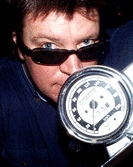|
|

Ramblings from my Travels With Guido column in Australian Motorcycle News.
Killer roads It's best to start this off with the statement that if you crashed you probably stuffed up. I can accept that theory in most situations and don't expect the government nanny, dressed in police uniform, to follow me around and tell me what a safe speed is. Been there done that. But I'd like to follow up on something mentioned in last issue's Travels, which was a hideously dangerous corner on a hilltop east of the Broadford bike race circuit that had been scattered with gravel as part of the road maker's art. This sort of thing happens all the time. Road repairers spray down a new tar seal to prevent water undermining the structure of the road, then leave a scattering of gravel to be embedded into the surface by traffic. Leaving the gravel isn't actually necessary, because it can be rolled into the surface with the right machinery - but it saves a lot of time and money. For the road maker. Reluctantly, I can live with this most of the time. It was unfortunate this practice stuffed up the brand new paint on Ms M's Kingswood, the day it came out of the spray booth. We're over it. It's always entertaining to see what the gravel fairies have left on mountain road and - touch something lucky - I haven't shed skin because of it yet. Though lots of adrenaline has been burned up in the cause of dodgy road-building. Last weekend I finally saw the proverbial red. Having mentioned the Broadford road in a column and the sheer bloody-minded danger it represented, I went back a week later to discover the gravel and dodgy warning signs in place. Still. A week is long enough to clean up the act. The combination of a hard tar surface, and gravel on top, is akin to ball bearings on ice. No grip and little hope. So for the second weekend in a row I went through the set of corners down the hill and this time there was a difference. In three out of the first four, you could see the telltale skid marks of a car losing control, and the corresponding paint and grazes in the rock wall (one place) and armco (two). There were some interesting marks on the fourth, but nothing conclusive. Clear unadulterated evidence that at least three vehicles had lost control and hit the hard stuff. How many people were in them and were they hurt? How many bikes went as well? Motorcycles don't leave the same impressive double-track gouges and acres of paint on rock or steel, so it's hard to tell. What makes this more damning is the road is well-used, so the tyre-marks in the loose stuff were probably recent and likely to be the latest of a number. Clyde from the justice division of the Lemmings MC assures us that this is outside the terms of the International Macadam Convention of '75. Scaring people, and even hurting the occasional punter, is apparently part of the rich tapestry of being a road maker. Though taking out several car and bike-loads of families for weekends on end is being greedy. And cruel. Clyde's answer is to wander down to the local manager of things road, and carve a skull and crossbones into the foremost part of his or her skull with a sharpened spade. Which seems calculated to cause extreme distress and pain. No less though, going by his argument, than that experienced by the crashees. Mr C is a difficult object to debate with by the time he's on his third bucket of Chateau Rosso - so the subtleties of balancing injustice against carving artwork into the perpetrator's head with a digging implement, and how it might look in court, now matter how good the barrister is, are often lost. He can see the humour in coming up with a turn that tightens up without warning and sends you bouncing and screaming "oh phuck" towards the scenery. Or even the art in embedding a silent policeman in an unlit inner Sydney suburban road that, decades after its installation, still catches out the odd adventurer. And there's some fun to be had with those neat "Whereyourgoingville" direction signs in country towns that suddenly spring up two metres short of the best braking distance ever achieved by Mick Doohan at 60 kay. Just so the locals can watch you two-wheel-drift past the corner and pull the famous J-turn and pretend you knew it was there all along. Or the famous "give way" sign placed in the middle of 300 kays of straight tarmac in nowhere. On the previously unmarked crossroad favoured by interstate road trains. Let's not forget the "Dead Dingbat's Creek" sign marking that wooden bridge - the one on a comfy high-speed stretch that suddenly drops away a metre and (just past that bush half-covering the road) turns 90 degrees about a bike-length short of where you actually land. Then there's the "gravel road" sign placed on the outer tip of a stretch of tar made in heaven. The one that's so fast and perfect that you only get time to read "grav" before you're heading in several different directions at once and reviewing the all too short mental movie of you life. Mr C also recommends some of the better city freeways where the sign pointing to where your going only appears on the left when you're in the right lane in peak hour. Just above your head, so the choice is a kamikaze mission under the bonnets of the Volvos or stopping off in the next state. Why not celebrate the efforts of the humble suburban roadnazi, such as planting a tree the size of a small planet in the midst of a roundabout that requires a three-point turn to get around and neatly designed so no-one can see what's coming in any direction. Usually that's accompanied by that tasteful paving with ceramic bricks - the ones that couldn't be used on the RN's front porch because they were too slippery to walk on. A final guernsey goes to the creators of the random traffic island. There have been a number of potential award winners in this category, with the outstanding items created by those who can plonk one smack in the middle of the easy line through a corner under the pretence of being a "traffic calming device". Very sexy, usually embellished with a completely unnecessary 'warning' sign that looks like a meat-carver if approached at the wrong angle. There's a minimalist artistic movement in this group - no warning signs, or fill behind the low and mean cement blocks that loom at ankle height in the dark for no apparent reason. But I dips me lid to the folk east of Broadford for coming up with the
most consistently dangerous effort, with the scalps on the rock face and
armco to prove it. Congratulations, Clyde will be around to present your
award...
|
Article by Guy Allen
home | sitemap | motorcycle books
Copyright © 1997-2025 dropbears ![]()



